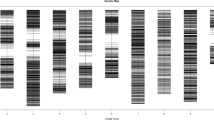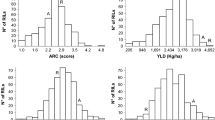Abstract
The moth bean (Vigna aconitifolia), possibly the most primitive crop of the genus Vigna, is a highly drought- and heat-resistant legume grown in arid areas. Moth bean domestication involved phenotypic changes, including reduction of seed dormancy and pod shattering, increased organ size, and earlier flowering and maturity. However, the genetics of the domestication process in moth bean is not known. In this study, we constructed a genetic linkage map for moth bean and used the map to identify quantitative trait loci (QTL) for domestication-related traits of an F2 population of 188 individuals produced from a cross of wild moth bean (TN67) and cultivated moth bean (ICPMO056). The genetic linkage map comprised 11 linkage groups (LG) of 172 simple sequence repeat markers and spanned a total length of 1016.8 centiMorgan (cM), with an average marker distance of 7.34 cM. A comparative genome analysis showed high genome synteny between moth bean and mungbean (Vigna radiata), adzuki bean (Vigna angularis), rice bean (Vigna umbellata), and yardlong bean (Vigna unguiculata). In total, 50 QTLs and 3 genes associated with 20 domestication-related traits were identified. Most of the QTLs belonged to five LGs (1, 2, 4, 7, and 10). Key traits related to domestication such as seed dormancy and pod shattering were controlled by large-effect QTLs (PVE > 20%) with one or two minor QTLs, whereas all other traits were controlled by one–seven minor QTLs, apart from seed weight, which was controlled by one major and seven minor QTLs. These results suggest that a small number of mutations with large phenotypic effects have contributed to the domestication of the moth bean. Comparative analysis of QTLs with related Vigna crops revealed that there are several domestication-related large-effect QTLs that had not been used in moth bean domestication. This study provides a basic genetic map and identified genome regions associated with domestication-related traits, which will be useful for the genetic improvement of the moth bean and related Vigna species.




Similar content being viewed by others
References
Arora RK, Nayar ER (1984) Wild relatives of crop plants in India. NBPGR Science Monograph 7, National Bureau of Plant Genetic Resources, New Delhi, India
Bisht IS, Bhat KV et al (2005) Diversity and genetic resources of wild Vigna species in India. Genet Resour Crop Evol 52:53–68. https://doi.org/10.1007/s10722-005-0286-0
Blair MW, Pedraza F et al (2003) Development of a genome-wide anchored microsatellite map for common bean (Phaseolus vulgaris L.). Theor Appl Genet 107:1362–1374. https://doi.org/10.1007/s00122-003-1398-6
Blink M, Jansen PCM (2006) Vigna aconitifolia (Jacq.) Maréchal. In: Blink M, Belay G (eds) Plant genetic resources of tropical Africa. 1. Cereals and pulses. Prota Foundation, Wageningen, Netherlands/Backhuys Publishers, Leiden, Netherlands, pp 200–203
Chaitieng B, Kaga A et al (2006) Development of black gram [Vigna mungo (L.) Hepper] linkage map and its comparison with an azuki bean [Vigna angularis (Wild.) Ohwi and Ohashi] linkage map. Theor Appl Genet 13(7):1261–1269. https://doi.org/10.1007/s00122-006-0380-5
Chankaew S, Isemura T et al (2014) Detection of genome donor species of neglected tetraploid crop Vigna reflexo-pilosa (créole bean), and genetic structure of diploid species based on newly developed EST-SSR markers from azuki bean (Vigna angularis). Plos One 9(8):e104990. https://doi.org/10.1371/journal.pone.0104990
Doi K, Kaga A et al (2002) Molecular phylogeny of genus Vigna subgenus Ceratotropis based on rDNA ITS and atpB-rbcL intergenic spacer of cpDNA sequences. Genetica 114:129–145. https://doi.org/10.1023/A:1015158408227
Flint-Garcia SA (2013) Genetics and consequences of crop domestication. J Agric Food Chem 61:8267–8276. https://doi.org/10.1021/jf305511d
Gaitán-Solís E, Duque MC et al (2002) Microsatellite repeats in common bean (Phaseolus vulgaris): isolation, characterization, and crossspecies amplification in Phaseolus ssp. Crop Sci 42:2128–2136. https://doi.org/10.2135/cropsci2002.2128
Guerra-Sanz JM (2004) New SSR markers of Phaseolus vulgaris from sequence databases. Plant Breed 123:87–89. https://doi.org/10.1046/j.0179-9541.2003.00929.x
Hammer K (1984) Das domestikations syndrom. Kulturpflanze 32:11–34
Han OK, Kaga A et al (2005) A genetic linkage map for azuki bean [Vigna angularis (Willd.) Ohwi & Ohashi]. Theor Appl Genet 111:1278–1287. https://doi.org/10.1007/s00122-005-0046-8
Isemura T, Kaga A et al (2007) Genome dissection of traits related to domestication in azuki bean (Vigna angularis) and their comparison with other warm season legumes. Ann Bot 100:1053–1071. https://doi.org/10.1093/aob/mcm155
Isemura T, Kaga A et al (2010) The genetics of the domestication of rice bean, Vigna umbellata. Ann Bot 106:927–944. https://doi.org/10.1093/aob/mcq188
Isemura T, Kaga A et al (2012) Construction of a genetic linkage map and genetic analysis of domestication related traits in mungbean (Vigna radiata). Plos One 7(8):e41304. https://doi.org/10.1371/journal.pone.0041304
Javadi F, Tun YT et al (2011) Molecular phylogeny of the subgenus Ceratotropis (genus Vigna, Leguminosae) reveals three eco-geographical groups and Late Pliocene–Pleistocene diversification: evidence from four plastid DNA region sequences. Ann Bot 108:367–380. https://doi.org/10.1093/aob/mcr141
Kaga A, Isemura T et al (2008) The genetics of domestication of azuki bean (Vigna angularis). Genetics 178:1013–1036. https://doi.org/10.1534/genetics.107.078451
Kaga A, Isemura T et al (2010) Asian Vigna genome research. Proceeding of the 14th NIAS international workshop on Genetic Resources, Genetic and Comparative Genomics of Legumes (Glycine and Vigna). http://www.gene.affrc.go.jp/pdf/misc/internatuinal-WS_14_33.pdf. Accessed 20 Aug 2018
Kang YJ, Kim SK et al (2014) Genome sequence of mungbean and insights into evolution within Vigna species. Nat Comm 5:5443. https://doi.org/10.1038/ncomms6443
Kongjaimun A, Kaga A, Tomooka N, Somta P, Shimizu T, Shu Y et al (2012a) An SSR-based linkage map of yardlong bean (Vigna unguiculata (L.) Walp. subsp. unguiculata sesquipedalis group) and QTL analysis of pod length. Genome 55:81–92. https://doi.org/10.1139/G11-078
Kongjaimun A, Kaga A et al (2012b) The genetics of domestication of yardlong bean, Vigna unguiculata (L.) Walp. ssp. unguiculata cv.-gr. sesquipedalis. Ann Bot 109:1185–1200. https://doi.org/10.1093/aob/mcs048
Kosambi DD (1944) The estimation of map distances from recombination values. Ann Eugen 12:172–175
Lewis G, Schire B et al (2005) Legumes of the world. Kew Royal Botanic Garden, Kew Scientist, London
Li CD, Fatokun CA et al (2001) Determining genetic similarities and relationships among cowpea breeding lines and cultivars by microsatellite markers. Crop Sci 41:189–197. https://doi.org/10.2135/cropsci2001.411189x
Li H, Ye G, Wang J (2007) A modified algorithm for the improvement of composite interval mapping. Genetics 175:361–374. https://doi.org/10.1534/genetics.106.066811
Lodhi MA, Ye GN et al (1994) A simple and efficient method for DNA extraction from grapevine cultivars and Vitis species. Plant Mol Biol Rep 12:6–13. https://doi.org/10.1007/BF02668658
Maréchal R, Mascherpa JM, Stainier F (1978) Etude taxonomique d’un grouped’especes des genres Phaseolus et Vigna (Papilonaceae) sur la base des donneesmorphologiques et polliques, traitees pour l’analyseinformatique. Boissiera 28:1–273
Meng L, Li H et al (2015) QTL IciMapping: Integrated software for genetic linkage map construction and quantitative locus mapping in biparental populations. Crop J 3(3):269–283. https://doi.org/10.1016/j.cj.2015.01.001
Purseglove JW (1974) Tropical crops: dicotyledons. Longman, London
Ross-Ibarra J (2005) Quantitative trait loci and the study of plant domestication. Genetica 123:197–204. https://doi.org/10.1007/s10709-004-2744-6
Saini A, Jawali N (2009) Molecular evolution of 5S rDNA region in Vigna subgenus Ceratotropis and its phylogenetic implications. Plant Syst Evol 280:187. https://doi.org/10.1007/s00606-009-0178-4
Sakai H, Naito K et al (2015) The power of single molecule real-time sequencing technology in the de novo assembly of eukaryotic genome. Sci Rep. https://doi.org/10.1038/srep16780
Seehalak W, Somta P et al (2009) Microsatellite markers for mungbean developed from sequence database. Mol Ecol Resour 9:862–864. https://doi.org/10.1111/j.1755-0998.2009.02655.x
Somta P, Kaga A et al (2006) Development of an interspecific Vigna linkage map between Vigna umbellata (Thumb.) Ohwi & Ohashi and V. nakashimae (Ohwi) Ohwi and Ohashi and its use in analysis of bruchid resistance and comparative genomics. Plant Breed 125(2):77–84. https://doi.org/10.1111/j.1439-0523.2006.01123.x
Somta P, Seehalak W, Srinives P (2009) Development, characterization and cross-species amplification of mungbean (Vigna radiata) genic microsatellite markers. Conserv Genet 10:1939–1943. https://doi.org/10.1007/s10592-009-9860-x
Suanum W, Somta P et al (2016) Co-localization of QTLs for pod fiber content and pod shattering in F2 and backcross populations between yardlong bean and wild cowpea. Mol Breed 36:80. https://doi.org/10.1007/s11032-016-0505-8
Takahashi Y, Somta P et al (2016) Novel genetic resources in the genus Vigna unveiled from gene bank accessions. PloS One 11(1):e0147568. https://doi.org/10.1371/journal.pone.0147568
Tangphatsornruang S, Somta P et al (2009) Characterization of microsatellites and gene contents from genome shotgun sequences of mungbean (Vigna radiata (L.) Wilczek). BMC Plant Biol 9:137. https://doi.org/10.1186/1471-2229-9-137
Tomooka N, Kashiwaba K et al (2000) The effectiveness of evaluating wild species: searching for sources of resistance to bruchid beetles in the genus. Vigna subgenus Ceratotropis Euphytica 115(1):27–41. https://doi.org/10.1023/A:1003906715119
Tomooka N, Vaughan DA, Moss H, Maxted N (2002) The Asian Vigna: genus Vigna subgenus Ceratotropis genetic resources. Kluwer Academic Publishers, New York
Tomooka N, Pandiyan M et al (2009) Collection and conservation of leguminous crops and their wild relatives in Tamil Nadu, India. Annual Report on Exploration and Introduction of Plant Genetic Resources (NIAS, Tsukuba, Japan). 25:83–109. http://www.gene.affrc.go.jp/pdf/publications/plant-exp_2008(25)_p83.pdf. Accessed 28 June 2018
van Oers CCCM (1989) Vigna aconitifolia (Jaqc.) Maréchal. In: van der Maesen LJG, Somaatmadja S (edi) Plant resources of South-East Asia No 1: pulse, Wageningen, Netherlands, pp. 66–67
van Ooijen JW (2006) JoinMap® 4.0: software for the calculation of genetic linkage maps in experimental population. Kyazma B.V., Wageningen
Wang XW, Kaga A et al (2004) The development of SSR markers by a new method in plants and their application to gene flow studies in azuki bean [Vigna angularis (Willd.) Ohwi & Ohashi]. Theor Appl Genet 109:352–360. https://doi.org/10.1007/s00122-004-1634-8
Whyte RO, Nilsson-Leissner G et al (1989) Agricultural studies 21: Legumes in agriculture. Food and Agriculture Organization, Rome
Yu K, Park SJ et al (2000) Integration of simple sequence repeat (SSR) markers into a molecular linkage map of common bean (Phaseolus vulgaris L.). J Hered 91:429–434. https://doi.org/10.1093/jhered/91.6.429
Acknowledgements
This research was supported by the Royal Golden Jubilee Ph.D. Program, the Thailand Research Fund. We are thankful to Chai Nat Field Crops Research Center, Thailand for field experiment in Thailand.
Funding
This research was supported by the Royal Golden Jubilee Ph.D. Program, the Thailand Research Fund.
Author information
Authors and Affiliations
Corresponding authors
Ethics declarations
Conflict of interest
The authors declare that they have no conflict of interest.
Ethics approval
This article does not contain any studies with human participants or animals performed by any of the authors.
Informed consent
Additional informed consent was obtained from all individual participants for whom identifying information is included in this article.
Additional information
Communicated by S. Hohmann.
Publisher’s Note
Springer Nature remains neutral with regard to jurisdictional claims in published maps and institutional affiliations.
Electronic supplementary material
Below is the link to the electronic supplementary material.
Supplementary Fig. S1
Frequency distribution of domestication-related traits in F2 population derived from a cross between wild moth bean accession “TN67” and cultivated moth bean accession “ICPMO056” (PDF 1433 KB)
Supplementary Fig. S2
Frequency distribution of domestication-related traits in F2:3 population derived from a cross between wild moth bean accession “TN67” and cultivated moth bean accession “ICPMO056” (PDF 948 KB)
Supplementary Table S1
Percentage of amplifiable and polymorphic SSR markers from four Vigna species in wild moth bean accession “TN67” and cultivated moth bean accession “ICPMO056” (DOCX 15 KB)
Supplementary Table S2
Correlation between domestication-related traits in the F2 population of the cross between wild moth bean (TN73) and cultivated moth bean (IPCMO056). The population was grown in Japan during summer to rainy season 2014 (DOCX 18 KB)
Supplementary Table S3
Correlation between domestication-related traits in the F2:3 population of the cross between cultivated moth bean (IPCMO056) and wild moth bean (TN67). The population was grown in Thailand during summer to rainy season of 2015 (DOCX 16 KB)
Rights and permissions
About this article
Cite this article
Yundaeng, C., Somta, P., Amkul, K. et al. Construction of genetic linkage map and genome dissection of domestication-related traits of moth bean (Vigna aconitifolia), a legume crop of arid areas. Mol Genet Genomics 294, 621–635 (2019). https://doi.org/10.1007/s00438-019-01536-0
Received:
Accepted:
Published:
Issue Date:
DOI: https://doi.org/10.1007/s00438-019-01536-0




